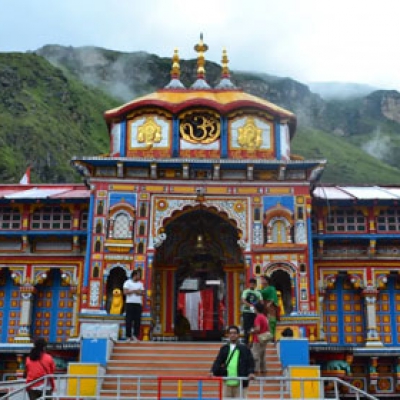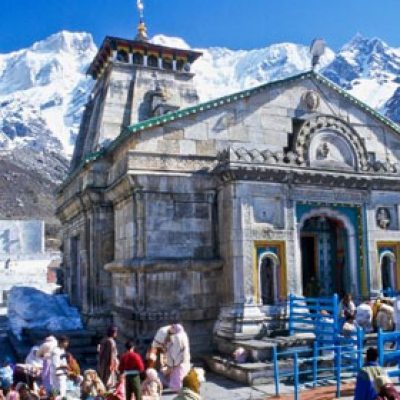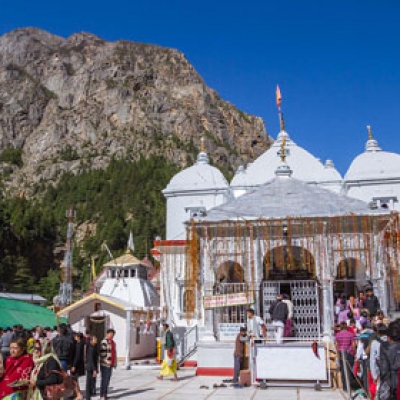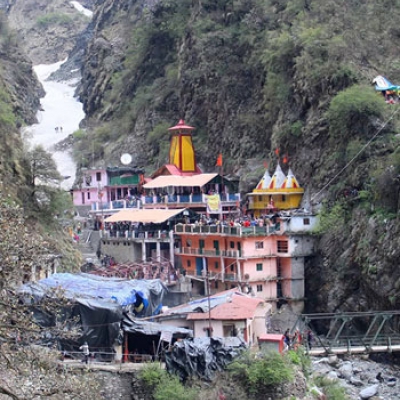
Char Dham Yatra
Char Dham describes the four pilgrimage sites in India, which are extensively venerated by Hindu supporters. These include Badrinath, Gangotri, Kedarnath and Yamunotri.
For every Hindu follower it has been mentioned in their Holy Book to pay a visit to these sacred places once in their lifetime to abolish their sins and wrong karma. Hence, Char Dham pilgrimage begins each year in the months of summer. This pilgrimage gets started with flair of fun and devotion and each year these four sites get flocked by thousands of pilgrims.
Badrinath
Structure in the twin mountain series of Nar as well as Narayan in Chamoli district in Uttarakhand, it is the most sacred place among four most important shrines. It is situated along the banks of Alaknanda River. Badrinath Temple along with the impressive Neelkanth Mountain ranges as background setting is a significant destination on the blessed itinerary of each spiritual Hindu. Some time ago this spot was complemented with Badris or wild berries therefore it became prominent as ‘Badri Van’. Badrinath Yatra is regarded as a must to visit for every pious Hindu disciple.
Fast Facts:
- Altitude : Located about 3,150 meters above sea-level
- Best Time to Visit : May-Sep
- Languages : Hindi, English, Garhwali
- Temperature : Summer 7 to 18°C & winter: -1 to -18°C
- Clothing : Light-woolen in summer as well as heavy woolens in winter
How To Reach Badrinath?
One can easily explore Badrinath through given means of transportation:
Air :Jolly Grant Airport is the nearby airport, which is near Dehradun. It is situated at a distance of 317 km from this holy place.
Train :Kotdwar and Rishikesh are nearby railheads that are located at a remoteness of 327 km & 297 km respectively.
Road :Badrinath features a well interlinked network of highways running from Haridwar, Rishikesh, Dehradun along with other Kumaon’s cities. A number of luxury buses run daily to and from these locations at fixed interval of time.
Major Attractions:
Badrinath Temple : This shrine, which is an abode to Lord Vishnu is situated on the right bank of Holy River Alaknanda and is perched at an elevation of about 3,150 meters above the sea-level. The temple is surrounded by a striking valley. The shrine was constructed by Adi Guru Shankaracharya (philosopher saint of 8th century), in the shape of a cone containing a small cupola or top of gilt bull as well as spire. Due to avalanches damage, it was renovated several times. The multihued Singh Dwara, which is the main doorway, gives it a contemporary look.
This place of worship contains three main divisions. The Garbha Griba (Sanctum Sanctorum), the Darshan Mandapa where rituals or ceremonies are conducted and the Sabha Mandapa, which is a palce for worshippers to assemble. Its complex features 15 idols with one meter high image of Badrinath with superbly engraved in black stone is the most appealing.
Before entering this shrine devotees need to take a holy dip in Tapt Kund, which is a natural thermal spring situated at the banks of Alaknanda. Its water is supposed to contain therapeutic properties.
Other Attractions In Badrinath:
Brahma Kapal : Located at the bank of Alaknanda. Hindus perform conciliating of their departed ancestors and relatives
Hemkund Sahib (43 kms.) : Significant pilgrimage of Hindus and Sikhs
Mana Village (4 kms.) : It features Vyas Gufa (Rock Cave) of Saint Ved Vyas who wrote Mahabharata, and Bhim Pul a natural suspension bridge over Vasundhara Falls which is 122 mts high and Sarasvati river.
Neelkanth : A snow-clad Pyramidical-shaped towering structure above Badrinath.
Alka Puri (15 kms.) : It is Alaknanda River’s ultimate source from the glacier proboscises of Satopanth and Bhagirath- Kharak glaciers.
Satopanth (25 kms.) : Positioned at an altitude of 4,402 mts above sea-level, it is a three-cornered lake along with a circumference of about 1 km. An experienced guide is needed to explore this region as it has dramatic landscapes.
Mata Murti Temple (3 kms.) : It is the temple dedicated to Sri Badrinathji’s mother.
Panch Prayag : The five most important confluences of Nandprayag, Deoprayag, Rudraprayag, Vishuprayag and Karnaprayag form the Panch-Prayag.
Joshimath (44 kms.) : It is the winter dwelling of Lord Vishnu and is positioned on the inclines above the convergence of Dhauliganga and Alaknanda.
Rudraprayag : The meeting point of Mandakini and Alaknanda rivers. The temples of Chamunda and Devi Rudranath are remarkable
Deoprayag : It is the convergence of Bhagirathi and Alaknanda rivers. It features Raghunath Temple and Shiv Temple. Karnaprayag : Here Pindar river meets with Alaknanda and features the holy places of Karna and Uma. Nandprayag : It is the junction of Mandakini and Alaknanda Rivers and its Gopalji Shrine is worth to visit. Srinagar : It is the ancient capital city of Garhwal and is a relevant cultural as well as educational hub. The temples of Kilkeshwar and Kamleshwar and the Shankar Math are remarkable. Vishnuprayag : It is the union of Dhauliganga and Alaknanda rivers and it also has a Vishnu Kund with ancient temple of Lord Vishnu. Mythological Legend of Badrinath Shrine : This shrine has a legend that when Ganga the deity of river was requested to move down the earth to assist suffering human race then at that time the earth wasn’t able to bear up the force of Ganga. Hence the forceful river was divided into 12 sacred waterways. Alaknanda was one of those holy channels that later turned out to be the dwelling of Lord Vishnu.
Panch Or Five Badris:
Apart from the foremost Badrinath place of pilgrimage, there are four other smaller but significant badri temples that are collectively recognized as Panch Badris. These include:
Bhavishya Badri : It is sited at an altitude of 2,744 m. and is s located at Subain close to Tapovan, ahich is about 17 km far from east of Joshimath. According to a famous Hindu legend, when the whole world will become victimize by evil then the two hiltops Nara as well as Narayan sited at Badrinath will lock up on each other and hence the route leading to the present Badrinath will get destroyed. This would also end up the whole world and mark the beginning of a novel world. Lord Badrinath then will then come into view at the Bhavishya Badri shrine.
Yogadhyan Badri : It is located at a height of 1920 m. and is nearby the main Badrinath shrine. It is the winter dwelling for Badrinath. Its Pandukeshwar is also a significant archaeological place to visit. Few years ago, this region got discovered with four ancient metal foils that were engraved with an explanation of several kings. These foils believed to be more than 1500 years old, and still are reserved at Joshimath, which is 30 km downstream.
Bridha Badri (Old Badri) : It is the 3rd temple, which is about 7 kms small of Joshimath, on the most important Rishikesh-Badrinath motor highway at Animath. It is supposed that Lord Vishnu was paid reverence here prior to its enshrinement by Adi Guru Shankaracharya at the foremost Badrinath seat. The temple remains open throughout the year.
Adi Badri : It is the farthest from the four other badris. By motorable route Ranikhet one can access it easily from Karnaprayag. Its complex possesses 16 small holy places with elaborate carvings. Seven out of these shrines belong to the late Gupta period. The main place of worship is renowned by a pyramid shaped elevated platform, with Lord Vishnu’s idol made of black stone.
Distance Chart Of Various Badrinath Locations:
- Rishikesh to Deoprayag: 70 kms
- Haridwar to Rishikesh: 24 kms
- Srinagar to Rudraprayag: 36 kms
- Deoprayag to Srinagar: 33 kms
- Karanprayag to Nandprayag: 21 kms
- Rudraprayag to Karanprayag: 31 kms
- Chamoli to Pipalkoti: 17 kms
- Nandprayag to Chamoli: 10 kms
- Joshimath to Badrinath: 45 kms
- Pipalkoti to Joshimath: 31 kms

Kedarnath
Kedarnath At A Glance:
It is a famous pilgrimage center sited in Uttarakhand, India and is one of the ‘Char Dhams’. It is a magnificent site that is located in the center of a wide plateau encapsulated by lofty snow-capped mountains. This place is famous for containing one of twelve Jyotirlingas of Lord Shiva.
Fast Facts:
- Altitude : 3553 m
- Best Season : May to October
- Weather : Summer 15 to 30°C, Winter 0 to 24°C
- Languages : Hindi, Gujarati, English
Kedarnath Temple & Its History:
The present shrine, constructed by Adi Shankaracharya in 8th century, rests closest to the site of an earlier holy place put up by Pandavas. The interiors of the assembly hall are adorned with various images of deities and mythological scenes. At the exterior of the temple entrance, there is a huge idol of the Nandi Bull, which stands as a guard.
This sacred place is dedicated to Lord Shiva and is said to be above 1,000 years old. This place of worship is built of heavy as well as evenly cut stone slabs. It has a Mandapa for visitors to get assembled and a Garbha Griha for worship. There is a conical rock structure inside the shrine, which is worshipped as Lord Shiva who is in Sadashiva form.
Mythological Myth Associated With Kedarnath:
When Pandavas required self-punishment following the great conflict of Mahabharata then they started to explore Lord Shiva. When they arrived over this place then they found that Shiva had transformed himself into a bull. Bhim, the strongest brother of Pandavas, chased Shiva who submerged deep into the ground and his tail was left over that Bhim grasped. This place is considered as the main Kedar and the rest of Shiva’s body appeared 4 other sites in Garhwal including Madhyamaheshwar, Tunganath, Rudranath and Kalpeshwar. These are called four other Kedars.
Rudranath : This is the site where Shiva's face is adulated. It is at an altitude of about 2,286 m above the sea level and is located at a distance of 23 km from Gopeshwar. 5 km of its distance is motorable however; one has to walk 18 km on foot to cover all distance. The trail lading towards this site passes through picturesque bugyals (fields) and wild orchards and entails hiking over high ridges. The place of worship provides outstanding sights of Nanda Devi, Hathi Parvat, Trishuli, and Nanda Ghungti along with many other peaks. There are also found numerous holy ponds (kunds) near the Rudranath shrine like Chandrakund, Suryakund, Tarakund. The entire region is completely captivating and matchless in scenic attractiveness. The temple of Anusuya Devi is sited on the trek to Rudranath that involves an extra 3 km trek.
Tungnath : This is the sacred place where Shiva's arms came out. This temple is situated at an elevation of 3,680 m and is considered as the highest Shiva shrine amongst the Panch Kedars. It is effortless to reach over here through Chopta, the adjacent road head.
Other Attractions:
Excursions Chorabari (Gandhi Sarovar-2 kms.) : It is small pool from where the eldest of Pandavas, Yudhishthir according to a belief have departed to paradise. The lake creates a captivating view when ice floats on this lake’s sparkling water.
Shankaracharya Samadhi : It is located behind Kedarnath temple and is the final resting site of Adi Guru Shankaracharya. It is said that after founding the four dhams in Indian land, he went for his final resting called Samadhi when he was just 32 years old.
Gaurikund (14 kms.) : This trek route leading towards Kedarnath is such a delight that you should not neglect during your journey. A place of worship dedicated to Gauri (Parvati) along with thermal springs with therapeutic property is noteworthy
Vasuki Tal (6 kms.) : It is encapsulated by lofty peaks and is 4,135 mts. above the sea level. A superior view of the Chaukhamba peaks can be observed from here.
Triyuginarayan (25 kms.) : It is the mythological site where the marriage ceremony of Lord shiva and Goddess Parvati took place. It leads a 5 trek from Sonprayag. Even today, the eternal flame, which is supposed to have been a bystander to the wedding, continuously burns at the front of the temple.
Sonprayag (20 kms.) : The meeting of Mandakini and Son Ganga rivers. The highway to Triyuginarayan turns away from here.
Ukshimath (60 kms) : It is the winter dwelling of god of the Kedarnath Temple as well as the seat of the Kedarnath’s Rawal.
Guptkashi (49 kms.) : Here the shrines of Vishwanath and Ardhnarishwar are remarkable. The remoteness between this place and Kedarnath is approx 49 kms, which is a striking trek itinerary.
Chandrashila (93 kms.) : This peak puts forwards a rare sight of snow-capped peaks. The alpine meadows and rhododendron woods lead the trek from Tungnath to this site.
Agastyamuni (73 kms.) : Renowned for the holy place dedicated to knowledgeable Agastya.
Deoria Tal (68 kms.) : The last bus terminus or point is Sari village on Chopta-Ukhimath highway from where a 2 km trek goes to Deoria Tal. This stunning lake is situated at a height of 2,438 mt that gives the impressive mirror image of snow-clad peaks in the pond water. It is perfect place for bird watching and angling.
How to reach kedarnath
Rail : Kotdwar (260 kms), Rishikesh (234 kms.)
Airport : For your Kedarnath tour there are daily flights available from Jolly Grant, Dehradun (251 kms). During your journey you can also take helicopter services to reach over Kedarnath temple.
Road : You can approach there on foot from Gaurikund that is interlinked by highway to Kotwar, Hairdwar, Rishikesh, Dehradun and other significant hill stations of Kumaun and Garhwal region.
Important Note : Cameras are not allowed to capture or to shoot Kedarnath’s image. The temple premises can be clicked.

Gangotri
This scenic pilgrimage in the boondocks of the mighty Himalaya is the most sacred place where Ganga also called the stream of life, moved towards earth for the first time. Gangotri is regarded as the source of the holy river Ganges and attracts thousands of explorers and pilgrims every year.
Fast Facts:
- Altitude : 3415 m
- Best Season : April to Jun, Sep to Nov
- Weather : Winter 0 to 10°C, Summer 10 to 15°C
- Languages : Hindi, Garhwali
Mythological Belief :
According to legends, Deity Ganga, the heaven’s daughter manifested herself as a river to absolve the wrong deeds of emperor Bhagirath’s forerunners, following his rigorous self-punishment of several centuries. To minimize the huge force of her fall, Lord Shiva collected her into his knotted locks. At her legendary origin she became famous as Bhagirathi. The place where she originated is known as Ganga Gomukh. According to other belief Pandavas carried out the grand ‘Deva Yagna’ to atone their kinsmen’s deaths in the clash of Mahabharata. The temple is made of white granite, which is 20 ft high.
Gangotri Temple : The Gangotri shrine is a famous pilgrimage site of India that attracts tourists from all parts of the world. In the temple, Goddess Ganges is applauded. This temple was built by a Gurkha emperor, Amar Singh Thapa in 18th century. One can easily be present at the Ganga aatri enchanted with holy Ganga songs.
Other Major Attractions:
Uttarkashi (99 kms.) : It is a significant pilgrimage site, which is positioned at a height of 1,150 mts above the sea-level. It is located on the bank of Bhagirathi River. Its Ekadash Rudra temple, Vishwanath temple, Gyaneshwar holy place and Kuteti Devi shrine are worth visiting temples. Nehru Institute of Mountaineering is the nearby site that you can also visit. During the 'Magh Mela' that is held every year, travelers visit Uttarkashi to take a sacred dip in Bhagirathi together with the picture of their village god.
Nandanvan Tapovan : A strenuous Gangotri trek next to the Gangotri Glacier takes you to picturesque Nandanvan. This is the base camp for the Bhagirathi peaks, which delivers a breathtaking sight of the adjacent Shivaling peak.
Gaumukh( 18 kms.) : The proboscis of the Gangotri Glacier as well as the origin of the Bhagirathi brook. To take a sacred dip in the ice-cold water, pilgrims walk up to the blessed spot on ponies or on foot.
Kedar Tal (18 kms.) : It is a beautiful lake that is located at an elevation of 4425 mts. above sea-level next to the impressive background of powerful Thalaiyasagar peak. It can be accessed through an irregular mountain path and it serves as the base camp for hiking to nearby peaks. You require a guide to get familiar with this trek.
Dayara Bugyal (93 kms.) : It is breathtakingly stunning meadow, sited at an altitude of 3,048 mts. A motorable highway links Bhatwari, which is 27 kms. Far from Uttarkashi with Raithal village. From here one needs to follow a 6 kms long trail to Dayara. Its popular attraction is the Sheshnag Temple. You can also walk down to Dodi Tal fFrom Dayara which is 30 kms far. During winters, this site provides amazing ski slopes, which covers 28 sq.kms of area.
Gangotri National Park : This Park came into existence in 1989 and is situated at Bhagirathi River’s upper catchment spot.
Narendranagar (239 kms.) : It is regarded as the novel capital of former Tehri state. It presents a superb sight of the Ganga valley of Rishikesh along with the meadows of Haridwar. It is also an ideal place to capture some magnificent images.
Nachiketa Tal (131 kms.) : A lovely trail through verdant woods leads to this serene place. Along the lake you can find a small shrine along the lake and beautiful environ are its specialties.
Tehri Dam (173 kms.) : Located at the junction of Bhilangna and Bhagirathi rivers, is the earlier capital of Tehri Garhwal. This site features a massive hydel project.
Getting In Gangotri:
- Railhead: Rishikesh( 249 kms).
- Airport: Jolly Grant, Dehradun (226 kms).
- Road: Well linked to Haridwar, Rishikesh, Dehradun as well as Delhi.

Yamunotri
Yamunotri At A Glance
Yamunotri is one of the holiest pilgrimage sites of India and one of the most significant parts of Char Dham. It is also the origin of Holy River Yamuna and is famous for its glaciers as well as thermal springs. It also is considered the most relevant halt on the itinerary of Hindu travelers. The Champasar Glacier is the ultimate source of Yamuna and is located underneath Banderpoonch Mountain at an elevation of 4,421 meters. This glacier isn’t easily accessible and is about 1km more further from Yamunotri temple.
History And Mythological Myth Associated With Yamunotri Temple
This temple is dedicated to deity Yamuna who is the daughter of Devi Sanjna and Lord Surya and is Lord Yama’s sister who is the God of Death. Yamuna was born at this glacier close to Kalind Parvat. People believe that one who takes a sanctified ablution in River Yamuna imparts a easy death.
The holy place of Yamuna is located at the left bank of this river and was first constructed during 19th century by Jaipur’s Maharani Gularia. In the earthquakes of 1923 as well as 1982, the temple was damaged; however it got rebuilt by Maharaja Pratap Shah, who was the emperor of Tehri Garhwal. To offer at this palce of worship, people prepare potatoes and rice, by dipping these tied in muslin cloth, in the hot water of the spring. People are allowed to click many photos.
Other Major Attractions At Yamunotri:
Hanumanchatti : The meeting point of Yamuna and Hanuman Ganga Rivers shapes the preliminary point for the picturesque Dodi TaL Trek.
Surya Kund : It is one of the relevant thermal springs, which is recognized for its extremely high temperature of 190°F. It is the place where pilgrims prepare rice along with potatoes to proffer to the goddess in the shrine.
Divya Shila : A massive rock support respected before going inside the Yamunotri Temple.
Chamba : It is a sylvan place that comes on the way to Tehri and provides an outstanding sight of the Himalayan peaks. It is located at a height of 1,676 mts. Here Chamba is a perfect summer retreat.
Sayanachatti : Along the banks of River Yamuna, it is the picturesque spot that creates a beautiful sight enrooted the trail leading towards Yamunotri.
Getting In Yamunotri:
Airport : Jolly Grant (196 kms) from Yamunotri through Dehradun
Road : Dharasu-107 kms, Rishikesh- 213, kms Tehri- 149 kms and Dehradun- 172 kms
Railhead : Rishikesh- 213 kms and Dehradun- 172 kms.